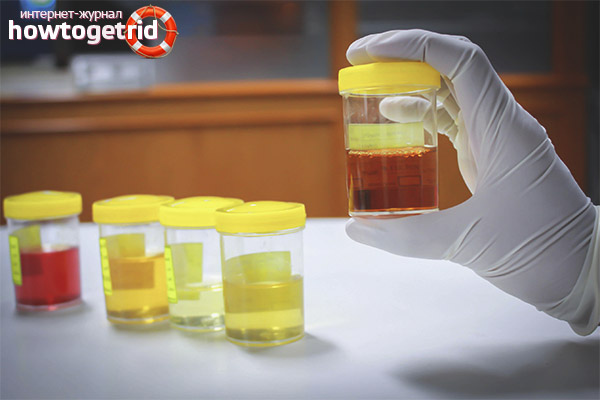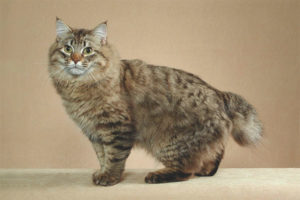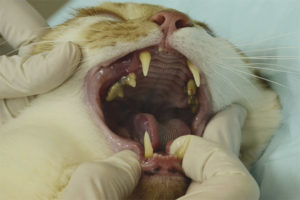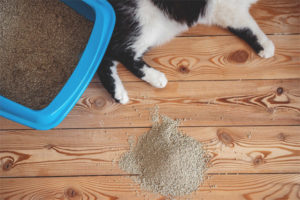The content of the article
One of the most serious indicators that a feline family pet has health problems is dark urine. Therefore, if the owner has noticed this problem, do not wait or self-medicate. In this case, you should immediately consult a specialist, because this symptom can be the cause of a rather serious disease of the animal. Of course, everything doesn’t end on the color of urine, it is also necessary to note its smell and level of transparency. These characteristics may be a consequence of diseases of the genitourinary system, and may also be one of the signs of dehydration.
In order to understand how to help your pet, you need to understand what may be the reasons for this. Further, the article will consider the most common options, why is this happening.
How to find out what color urine in a cat
If the cat is completely healthy, then the color of her urine should be yellowish, or amber. This shade of the excreted fluid gives urobilin. If this component is not excreted from the body, then its increased capacity can carry a negative effect on the animal’s nervous system. But, if the liquid is saturated yellow or even dark, then this can be the cause of the ailment, which must be treated immediately. The problem is that finding out about it is not so easy. Not every owner watches his cat when he goes to the toilet. Moreover, now most cats go to the tray in which the filler is poured.
Therefore, in order to be able to control the color of the cat’s urine, it is worth teaching her to walk into the tray without filler. After the cat has done its job, it is necessary to pour the liquid into a transparent container, and then put a white sheet of paper under it. Having done the described manipulations, it will be much easier to determine the real color of the animal’s urine.
You can also do a little simpler if you do not want to do unnecessary actions, or if the cat does not want to go to the toilet without filler. In the tray on top of the filler, you can put a piece of white cloth, and when the pet goes to the toilet, you can evaluate its color.
It is worth noting that if the urine is not dark, but transparent, you should not rejoice, because it can also be the cause of the disease. Of course, in some cases this can be explained by the fact that the cat drank a significant amount of water, and for this reason the animal's body did not manage to produce the required amount of urobilin. And, accordingly, the urine did not stain. But it can also be the cause of serious illnesses, such as, for example, diabetes. Also, in such cases, pathologies of the adrenal glands of the cat, or of the endocrine glands, are observed. An additional symptom of these diseases can be prolonged apathy and poor appetite. If these signs were found in the pet, you should not delay it, and it is better to seek help from a specialist who can make an accurate diagnosis and prescribe the appropriate treatment.
Causes of a cat's urine color change
Dark colored urine can form for many reasons. And they can be both physiological and pathological. It is quite difficult to understand on your own what caused this problem, but you can find out about the main reasons that can provoke this:
- The presence of infection in the urinary or reproductive system of the pet.
- The formation of stones in the kidneys, bladder.
- The state of dehydration of a cat.
- The period of sexual hunting in an animal.
- Other ailments that need emergency care.
Options for changing the color of urine
Of course, you should not independently solve the problem of your pet, because this is fraught with grave consequences. But it’s worth knowing approximately what diseases a cat may have, depending on the color of her urine. Best of all, an expert understands this, and he will be able to tell what to do in a specific situation.
Variations in the color of cat urine:
- Saturated yellow color may indicate that the pet has a slight degree of dehydration. This color can be observed in animals that did not drink liquids for a long time in hot weather. Also, this shade happens in cats that have been dieting for some time, or have been sterilized. This degree of dehydration does not pose a danger to a cat at all if you make sure that she drinks the necessary amount of water.
- Urine with a reddish tint may indicate that the animal is suffering from some kind of infection that lives in the genitourinary system. It may also be due to the presence of stones, or a symptom of cystitis in a cat. It is worth noting that if such a symptom is observed in a pet that is sterilized or neutered, then this is a clear sign of cystitis and stones at the same time. Stones and sand that form in the urinary system can injure the bladder through movement. Because of this, wounds and erosion can appear in which infections form. If the red color of the urine does not go away for a long time, you should immediately contact a veterinary clinic, because delaying treatment can lead to death of the animal. Sometimes a reddish tint may indicate an internal bruise of feline organs.
- If the pet has brown urine, then this is a clear sign of the presence of a large number of harmful bacteria. Another reason for such urine may be a low level of blood coagulation of the animal. Additional symptoms of this ailment can be weight loss and loss of appetite, as well as a decrease in the level of interest in everything that happens around. Sometimes the brown color of the urine may indicate that it mixed with the cat's menstrual flow, but this only applies to sexually mature individuals that survive the period of sexual hunting.
- Urine with blood is the result of a severe degree of pyelonephritis or glomerulonephritis.
- Discharges that have a greenish tint clearly indicate that the cat has liver problems. Parenchymal jaundice is one of the most serious ailments that cause urine to stain green. In this case, the pet needs emergency care, because the consequence of this disease can be fatal.
Taking material for analysis
To conduct an examination with a veterinarian, and he prescribed the necessary and correct treatment, it is worth giving cat urine for analysis. The first thing to consider when taking material for analysis is that it should be fresh. If the received material is stored for more than two hours, then there is no point in analyzing it. If necessary, cat urine can be stored for some time, but with a high level of cold.
Urine collection occurs naturally when the cat goes into the tray in the morning. There are also two more ways of collecting material for research - this is the puncture method and taking with a catheter.
It will be safer and easier if the disease is not treated, but simply does not allow its development. Because any disease can leave its mark on the health of the pet, especially when it comes to pets aged. Also, this is a significant waste of not only money, but also time and nerves.
It often happens that the owners ignore or do not notice the primary symptoms, which then develop into a whole bunch of symptoms and are the result of a serious illness.And such diseases can not be cured even by the most experienced and knowledgeable specialists in this field. To prevent this from happening, the first thing to do when you notice a dark urine in your pet is to go to the veterinary clinic for an examination. Host observation is the most effective prophylactic for animal health.










Submit